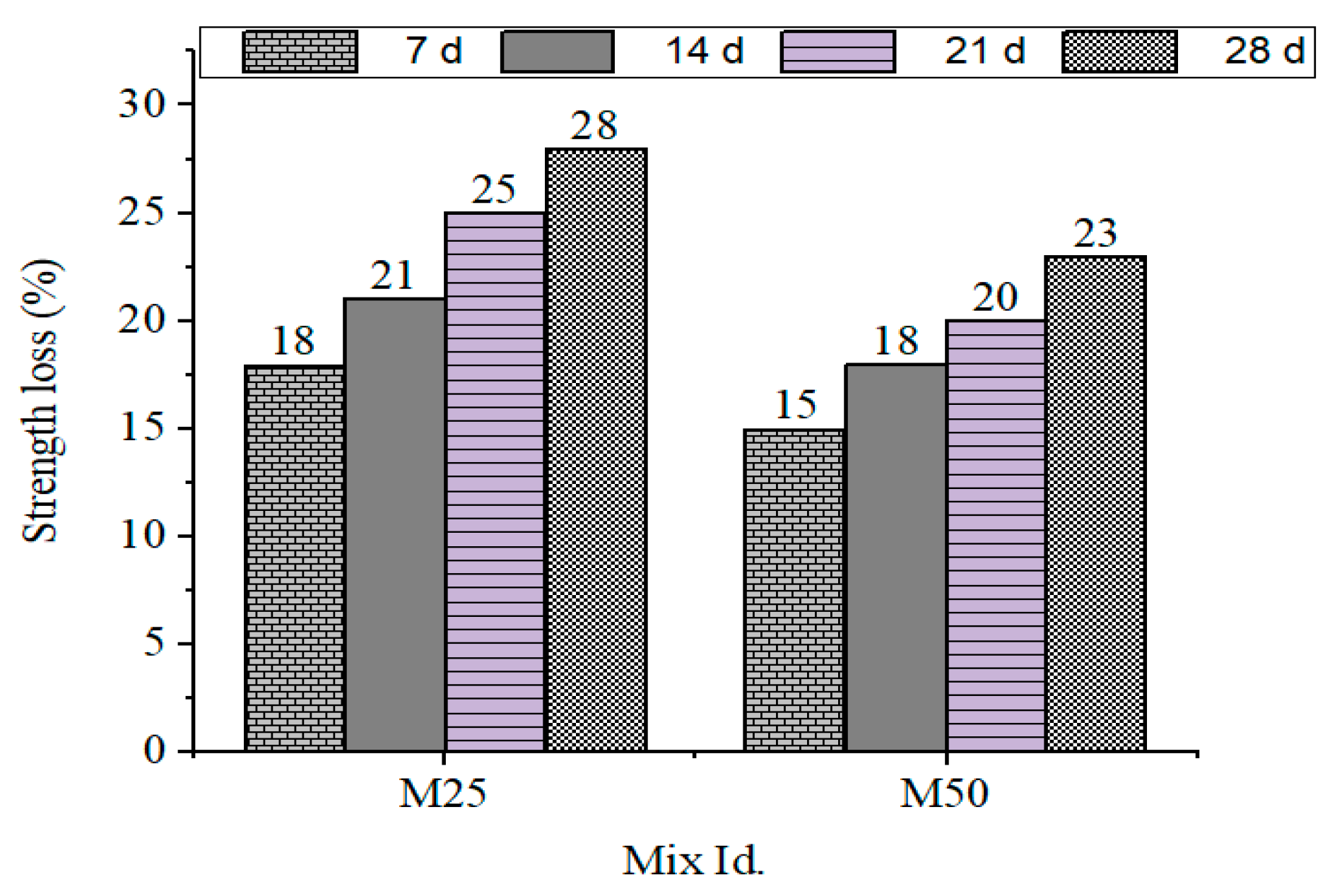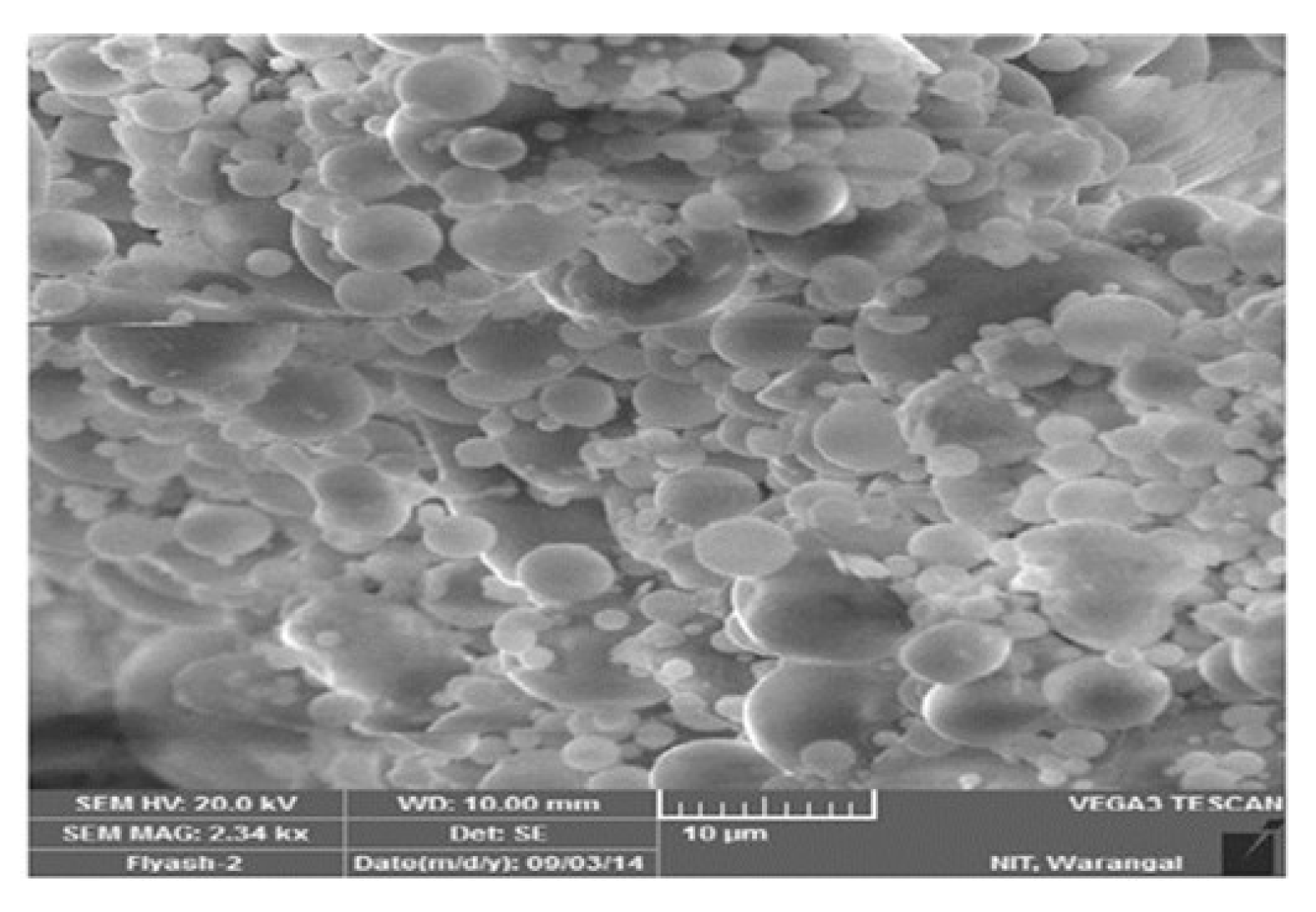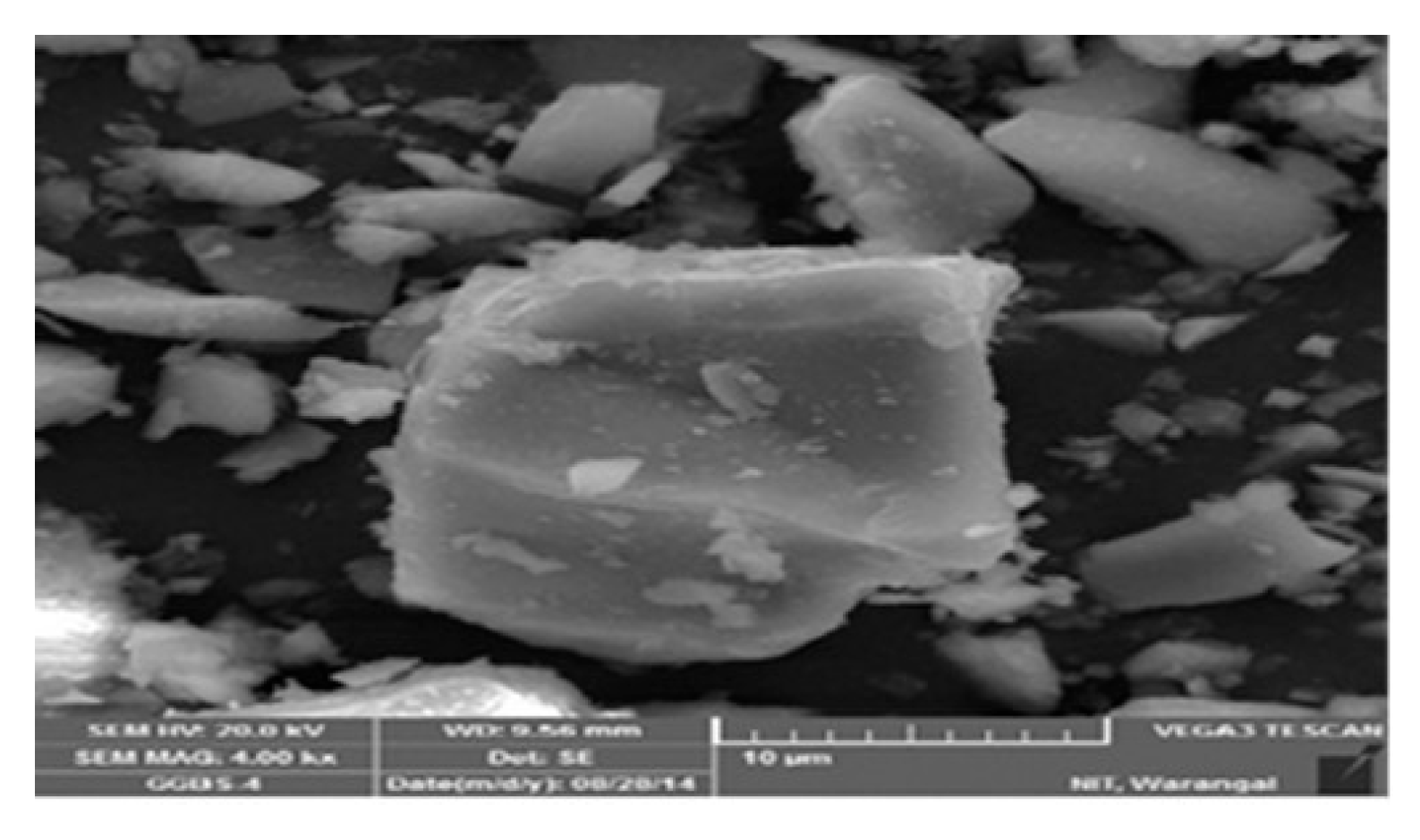Experimental Study on Acid Resistance of Geopolymer Concrete Incorporating Fly Ash and GGBS: Towards Low-Carbon and Sustainable Construction
Abstract
1. Introduction
1.1. Global Context and Motivation
1.2. Geopolymer Concrete as an Alternative
1.3. Sustainability Significance
1.4. Acid Resistance in GPC and OPC
1.5. Research Gaps and Objectives
- To investigate the mechanical properties of GPC with 10%, 30%, and 50% GGBS replacement levels.
- To determine deterioration during exposure to sulfuric and nitric acids in terms of mass and strength loss indices.
- To conduct microstructural analyses (XRD and SEM) for understanding degradation mechanisms.
- To examine the findings within the broader discourse on sustainable and low-carbon construction.
2. Materials and Methods
2.1. Materials
2.1.1. Fly Ash (Class F)
2.1.2. Alkaline Activator Solution
2.1.3. Superplasticizer
2.2. Mix Proportions
2.3. Specimen Preparation and Casting
- ➢
- Compressive strength: Cubes of 150 × 150 × 150 mm.
- ➢
- Split tensile strength: Cylinders of 150 mm diameter × 300 mm height.
- ➢
- Flexural strength: Prisms of 100 × 100 × 500 mm.
2.4. Curing Regime
2.5. Acid Resistance Testing
2.6. Microstructural Analysis
2.7. Testing Arrangements and Test Processes
- Compressive Strength: 150 × 150 × 150 mm size cubes were subjected through compressive testing machine (CTM) with a capacity of 2000 kN, according to IS 516:2018. The loading rate was kept at 140 kg/cm2/min until failure.
- Split Tensile Strength: Cylindrical specimens with 150 mm diameter and 300 mm height were tested in accordance with IS 5816:1999. To promote even distribution, the load was placed on the cylinder in a diametrical manner with the help of strips made of steel (3 mm thick).
- Flexural Strength: Beam samples (100 × 100 × 500 mm) were subjected to three-point loading in accordance with IS 516:2018, with a span of 400 mm and loading rate of 180 kg/min.
- Demolding of the samples followed after 24 h, and they were cured at 27 ± 2 °C, RH 60–70, with vibration compaction (30 s) and no bleeding/segregation.
3. Results
3.1. Compressive Strength
3.2. Tensile Strength
3.3. Flexural Strength
3.4. Acid Resistance—Mass Loss
3.5. Acid Resistance—Residual Strength
- ➢
- Sulfuric acid exposure: The strength loss ranged from 28% (GPC10) to 23% (GPC50).
- ➢
- Nitric acid exposure: The strength loss ranged from 28% (GPC10) to 22% (GPC50).
3.6. Microstructural Analysis
3.6.1. XRD Findings
3.6.2. SEM Findings
4. Discussion
4.1. Mechanical Properties of Fly Ash–GGBS Geopolymer Concretes
4.2. Acid Resistance and Durability
4.3. Microstructural Insights
4.4. Sustainability and Environmental Concerns
5. Conclusions
5.1. Summary of Key Findings
5.1.1. Strength Development
5.1.2. Acid Resistance
5.1.3. Microstructural Insights
5.1.4. Durability Trade-Offs
5.1.5. Sustainability Contributions
5.1.6. Practical Guidance
5.2. The Implications for Construction Practice
5.3. Future Research Directions
Author Contributions
Funding
Data Availability Statement
Conflicts of Interest
References
- Scrivener, K.L.; John, V.M.; Gartner, E.M. Eco-efficient cements: Potential, economically viable solutions for a low-CO2 cement-based materials industry. Cem. Concr. Res. 2018, 114, 2–26. [Google Scholar] [CrossRef]
- Poloju, K.K. Geopolymer Concrete: Principles, Applications and Testing Methods, 1st ed.; Series ISSN 2191-530X, Springer Briefs in Applied Sciences and Technology; Springer: Singapore, 2025; ISBN 978-981-96-2478-2. [Google Scholar]
- Andrew, R.M. Global CO2 emissions from cement production, 1928–2018. Earth Syst. Sci. Data 2019, 11, 1675–1710. [Google Scholar] [CrossRef]
- Mehta, P.K.; Monteiro, P.J.M. Concrete: Microstructure, Properties, and Materials, 4th ed.; McGraw-Hill: New York, NY, USA, 2014. [Google Scholar]
- Chen, Y.; Gao, J.; Tang, L.; Li, X. Resistance of concrete against combined attack of chloride and sulfate under drying–wetting cycles. Constr. Build. Mater. 2016, 106, 650–658. [Google Scholar] [CrossRef]
- Alexander, M.; Bertron, A.; De Belie, N. (Eds.) Performance of Cement-Based Materials in Aggressive Aqueous Environments; Springer: Dordrecht, The Netherlands, 2013. [Google Scholar] [CrossRef]
- Davidovits, J. Geopolymers: Inorganic polymeric new materials. J. Therm. Anal. 1991, 37, 1633–1656. [Google Scholar] [CrossRef]
- Poloju, K.K. Advanced Materials and Sustainability in Civil Engineering, 1st ed.; Series ISSN 2191-530X, Springer Briefs in Applied Sciences and Technology; Springer: Singapore, 2023; ISBN 978-981-16-5949-2. [Google Scholar] [CrossRef]
- Duxson, P.; Fernández-Jiménez, A.; Provis, J.L.; Lukey, G.C.; Palomo, A.; van Deventer, J.S.J. Geopolymer technology: The current state of the art. J. Mater. Sci. 2007, 42, 2917–2933. [Google Scholar] [CrossRef]
- Provis, J.L.; van Deventer, J.S.J. (Eds.) Geopolymers: Structures, Processing, Properties and Industrial Applications; Woodhead Publishing: Cambridge, UK, 2009. [Google Scholar]
- Wang, S.-D.; Scrivener, K.L.; Pratt, P.L. Factors affecting the strength of alkali-activated slag. Cem. Concr. Res. 1994, 24, 1033–1043. [Google Scholar] [CrossRef]
- Jawahar, J.; Mounika, G. Strength properties of fly ash and GGBS based geo polymer concrete. Asian J. Civ. Eng. 2016, 17, 127–135. [Google Scholar]
- Habert, G.; D’Espinose de Lacaillerie, J.-B.; Roussel, N. An environmental evaluation of geopolymer concrete production: Reviewing current research trends. J. Clean. Prod. 2011, 19, 1229–1238. [Google Scholar] [CrossRef]
- Poloju, K.K.; Annadurai, S.; Manchiryal, R.K.; Goriparthi, M.R.; Baskar, P.; Prabakaran, M.; Kim, J. Analysis of Rheological Characteristic Studies of Fly-Ash-Based Geopolymer Concrete. Buildings 2023, 13, 811. [Google Scholar] [CrossRef]
- Poloju, K.K.; Manchiryal, R.K.; Al Balushi, Y.A.A.; Al Banna, W.N.M. Variation of sodium hydroxide concentration impact on rheological properties of geopolymer paste. Int. J. Adv. Appl. Sci. 2023, 10, 62–68. [Google Scholar] [CrossRef]
- Shi, C.; Jiménez, A.F.; Palomo, A. New cements for the 21st century: The pursuit of an alternative to Portland cement. Cem. Concr. Res. 2011, 41, 750–763. [Google Scholar] [CrossRef]
- Nath, P.; Sarker, P.K. Effect of GGBS on setting, workability and early strength properties of fly ash geopolymer concrete cured in ambient condition. Constr. Build. Mater. 2014, 66, 163–171. [Google Scholar] [CrossRef]
- Nirmala Kumar Parshwanath, R. Quantities of sodium hydroxide solids and water to prepare sodium hydroxide solution of given molarity for Geopolymer Concrete mixes. Indian Concr. J. 2016, 90, 68–79. [Google Scholar]
- Wallah, S.E.; Rangan, B.V. Low-Calcium Fly Ash-Based Geopolymer Concrete: Long-Term Properties (Research Report GC 2); Curtin University of Technology: Perth, Australia, 2006. [Google Scholar]
- Rashad, A.M. A comprehensive overview about the influence of different additives on the properties of alkali-activated slag–A guide for Civil Engineer. Constr. Build. Mater. 2015, 87, 29–55. [Google Scholar] [CrossRef]
- Kathirvel, P.; Kaliyaperumal, S.R.M. Performance of alkali activated slag concrete under aggressive environment. Sci. Iran. Trans. A Civ. Eng. 2018, 25, 2451–2460. [Google Scholar] [CrossRef]
- Zhang, J.; Shi, C.; Zhang, Z.; Ou, Z. Durability of alkali-activated materials in aggressive environments: A review on recent studies. Constr. Build. Mater. 2017, 152, 598–613. [Google Scholar] [CrossRef]
- Ralli, Z.G.; Pantazopoulou, S.J. State of the art on geopolymer concrete. Int. J. Struct. Integr. 2021, 12, 511–533. [Google Scholar] [CrossRef]
- Wang, H.; Zentar, R.; Wang, D.; Dong, L.; Sun, D. Recycling single use surgical face mask waste for reinforcing cement-treated/untreated dredged marine sediments: Strength, deformation and micro-mechanisms analysis. Constr. Build. Mater. 2024, 449, 138450. [Google Scholar] [CrossRef]
- Poloju, K.; Anil, V.; Manchiryal, R.K. Impact of nano-silica on strength and durability properties of self-compacting concrete. Int. J. Adv. Appl. Sci. 2017, 4, 120–126. [Google Scholar] [CrossRef]
- Wang, H.; Zhang, J.; Wang, D.; Zentar, R.; Lang, L.; Sun, D.; Dong, L. Bibliometric analysis of research on recycling dredged sediment as construction material during the past three decades: Trends and focal points. J. Soils Sediments 2025, 25, 2126–2151. [Google Scholar] [CrossRef]
- Çelik, A.; Karalar, M.; Aksoylu, C.; Mydin, M.; Althaqafi, E.; Yılmaz, F.; Umiye, O.; Özkılıç, Y. Effect of GBFS Ratio and Recycled Steel Tire Wire on the Mechanical and Microstructural Properties of Geopolymer Concrete under Ambient and Oven Curing Conditions. Case Stud. Constr. Mater. 2024, 21, e03890. [Google Scholar] [CrossRef]
- Ozkılıç, Y.O.; Çelik, A.İ.; Aksoylu, C.; Karalar, M.; Mydin, M.A.O.; Althaqafi, E.; Yılmaz, F.; Umiye, O.A. Shear and flexural performance of reinforced geopolymer concrete beams cured under ambient and oven conditions with environmentally friendly waste steel tire wire additives. Sci. Rep. 2025, 15, 22765. [Google Scholar] [CrossRef] [PubMed]
- Çelik, A.İ.; Özkılıç, Y.O.; Bahrami, A.; Hakeem, I.Y. Mechanical performance of geopolymer concrete with micro silica fume and waste steel lathe scraps. Case Stud. Constr. Mater. 2023, 19, e02548. [Google Scholar] [CrossRef]
- Li, J.; Tay, B.W.Y.; Lei, J.; Yang, E.-H. Experimental investigation of Seebeck effect in metakaolin-based geopolymer. Constr. Build. Mater. 2021, 272, 121615. [Google Scholar] [CrossRef]
- Bakharev, T. Resistance of geopolymer materials to acid attack. Cem. Concr. Res. 2005, 35, 658–670. [Google Scholar] [CrossRef]
- Fernández-Jiménez, A.; Palomo, A. Characterization of fly ashes. Potential reactivity as alkaline cement. Fuel 2003, 82, 2259–2265. [Google Scholar] [CrossRef]
- Mallikarjuna Rao, G.; Gunneswara Rao, T.D. A quantitative method of approach in designing the mix proportions of fly ash and GGBS-based geopolymer concrete. Aust. J. Civ. Eng. 2018, 16, 53–63. [Google Scholar] [CrossRef]
- Adak, D.; Sarkar, M.; Mandal, S. Effect of nano-silica on strength and durability of fly ash based geopolymer mortar. Constr. Build. Mater. 2014, 70, 453–459. [Google Scholar] [CrossRef]
- Shaikh, F.U.A. Mechanical and durability properties of fly ash geopolymer concrete containing recycled coarse aggregates. Int. J. Sustain. Built Environ. 2016, 5, 277–287. [Google Scholar] [CrossRef]
- Poloju, K.K.; Srinivasu, K. Influence of GGBS and concentration of sodium hydroxide on strength behavior of geopolymer mortar. Mater. Today Proc. 2022, 65, 702–706. [Google Scholar] [CrossRef]
- Poloju, K.K.; Srinivasu, K. Impact of GGBS and strength ratio on mechanical properties of geopolymer concrete under ambient curing and oven curing. Mater. Today Proc. 2021, 42, 962–968. [Google Scholar] [CrossRef]
- Rathanasalam, V.; Perumalsami, J.; Jayakumar, K. Effect of ultrafine ground granulated blast-furnace slag (UFGGBFS) and copper slag on ambient cured geopolymer concrete. Ann. Chim.-Sci. Matériaux 2019, 43, 377–382. [Google Scholar] [CrossRef]
- Patankar, S.V.; Jamkar, S.S.; Ghugal, Y.M. Effect of concentration of sodium hydroxide and degree of heat curing on fly ash-based geopolymer mortar. Indian J. Mater. Sci. 2014, 2014, 938789. [Google Scholar] [CrossRef]
- Bernal, S.A.; Provis, J.L.; Rose, V.; Mejía de Gutiérrez, R. Evolution of binder structure in sodium silicate-activated slag–metakaolin blends. Cem. Concr. Compos. 2011, 33, 46–54. [Google Scholar] [CrossRef]
- Nath, P.; Sarker, P.K. Use of OPC to improve setting and early strength properties of low-calcium fly ash geopolymer concrete cured at room temperature. Cem. Concr. Compos. 2015, 55, 205–214. [Google Scholar] [CrossRef]
- Patankar, S.V.; Ghugal, Y.M.; Jamkar, S.S. Mix Design of Fly Ash Based Geopolymer Concrete. In Advances in Structural Engineering; Matsagar, V., Ed.; Springer: New Delhi, India, 2015. [Google Scholar] [CrossRef]
- Shaikh, F.; Supit, S. Mechanical and durability properties of high volume fly ash (HVFA) concrete containing calcium carbonate (CaCO3) nanoparticles. Constr. Build. Mater. 2014, 70, 309–321. [Google Scholar] [CrossRef]
- Adam, A.; Horianto, X.X.X. The Effect of Temperature and Duration of Curing on the Strength of Fly Ash Based Geopolymer Mortar. Procedia Eng. 2014, 95, 410–414. [Google Scholar] [CrossRef]
- Law, D.; Adam, A.; Molyneaux, T.; Patnaikuni, I.; Wardhono, A. Long term durability properties of class F fly ash geopolymer concrete. Mater. Struct. 2014, 48, 721–731. [Google Scholar] [CrossRef]
- Pan, Z.; Tao, Z.; Cao, Y.F.; Wuhrer, R.; Murphy, T. Compressive strength and microstructure of alkali-activated fly ash/slag binders at high temperature. Cem. Concr. Compos. 2017, 86, 9–18. [Google Scholar] [CrossRef]
- Fernández-Jiménez, A.; Palomo, A.; Criado, M. Microstructure development of alkali-activated fly ash cement: A descriptive model. Cem. Concr. Res. 2005, 35, 1204–1209. [Google Scholar] [CrossRef]
- Poloju, K.K.; Al Banna, W.N. Microstructure Studies and Strength Determination of Different Binder Contents of Geopolymer Concrete. In Advancements in Science and Technology for Healthcare, Agriculture, and Environmental Sustainability; Karras, D.A., Thakur, S., Oruganti, S.K., Eds.; CRC Press: Boca Raton, FL, USA, 2024; ISBN 978-1-032-70832-4. [Google Scholar]
- Al Banna, W.N.; Poloju, K.K. Study on Characteristics of Geopolymer Concrete. In Recent Advances in Civil Engineering; Kumar, P.G., Subramaniam, K.V.L., Santhakumar, S.M., Satyam, D.N., Eds.; Lecture Notes in Civil Engineering; Springer: Singapore, 2022; Volume 233, pp. 539–551. ISSN 2366-2557. [Google Scholar]
- Wong, L.S. Durability Performance of Geopolymer Concrete: A Review. Polymers 2022, 14, 868. [Google Scholar] [CrossRef]
- Ryu, G.S.; Lee, Y.B.; Koh, K.T.; Chung, Y.S. The mechanical properties of fly ash-based geopolymer concrete with alkaline activators. Constr. Build. Mater. 2013, 47, 409–418. [Google Scholar] [CrossRef]
- Shi, X.; Feng, Y.; Zhang, Y.; Su, Y. A comprehensive investigation on sulphate resistance of geopolymer recycled concrete: Macro and micro properties. Constr. Build. Mater. 2023, 403, 133052. [Google Scholar] [CrossRef]
- Ren, X.; Zhang, L. Experimental Study of Geopolymer Concrete Produced from Waste Concrete. J. Mater. Civ. Eng. 2019, 31, 04019114. [Google Scholar] [CrossRef]
- Vora, P.R.; Dave, U.V. Parametric studies on compressive strength of geopolymer concrete. Procedia Eng. 2013, 51, 210–219. [Google Scholar] [CrossRef]
- Deb, P.S.; Nath, P.; Sarker, P.K. The effects of ground granulated blast-furnace slag blending with fly ash and activator content on the workability and strength properties of geopolymer concrete cured at ambient temperature. Mater. Des. 2014, 62, 32–39. [Google Scholar] [CrossRef]
- Patankar, S.; Jamkar, S.; Ghugal, Y. Effect of Water-to-Geopolymer Binder Ratio on the Production of Fly ash Based Geopolymer Concrete. Int. J. Adv. Technol. Civ. Eng. 2013, 2, 79–83. [Google Scholar] [CrossRef]
- Nematollahi, B.; Sanjayan, J.; Shaikh, F. Synthesis of heat and ambient cured one-part geopolymer mixes with different Grades of sodium silicate. Ceram. Int. 2015, 41, 5696–5704. [Google Scholar] [CrossRef]
- Olayinka, R.; Jafari, R.; Fiset, M. Shrinkage Characteristics of Geopolymer Concrete: A Comprehensive Review. Materials 2025, 18, 4528. [Google Scholar] [CrossRef]
- Olivia, M.; Nikraz, H. Properties of fly ash geopolymer concrete designed by Taguchi method. Mater. Des. 2011, 36, 191–198. [Google Scholar] [CrossRef]
- Salas, D.; Ramirez, A.; Ulloa, N.; Baykara, H.; Boero, A. Life cycle assessment of geopolymer concrete. Constr. Build. Mater. 2018, 190, 170–177. [Google Scholar] [CrossRef]
- Vasudevareddy, P.; Reddy, K. Effect of graphene oxide and nano silica on mechanical and durability properties of cement mortar. Mater. Today Proc. 2022, 60, 1042–1050. [Google Scholar] [CrossRef]








| Properties | Fly Ash (%) | GGBS (%) |
|---|---|---|
| Color | Gray | White |
| pH | 8.12 | 10.32 |
| Specific gravity | 2.20 | 2.90 |
| Chemical Composition | Fly Ash (%) | GGBS (%) |
|---|---|---|
| Calcium Oxide | 3.48 | 40.52 |
| Silica | 60.10 | 34 |
| Alumina | 26.50 | 13.12 |
| Iron Oxide | 4.25 | 0.80 |
| Magnesia | 1.25 | 7.89 |
| Sulphur Trioxide | 0.35 | 0.90 |
| Soda/Potassium | 0.22 | Nil |
| LOI | 0.88 | Nil |
| Properties | NaOH | Na2SiO3 |
|---|---|---|
| Molar (mass) | 40 g/mol | 125.1 g/mol |
| Density | 2.08 g/cc | 2.62 g/cc |
| Boiling stage | 1386 °C | - |
| Melting stage | 322 °C | 1086 °C |
| Properties | Fine Aggregate | Coarse Aggregate |
|---|---|---|
| Specific gravity | 2.63 | 2.7 |
| Density | 1.62 kg/L | 1.723 kg/L |
| Water absorption | 1.26% | 0.49% |
| Fineness modulus | 2.62 | 5.35 |
| Void ratio | 0.42 | 0.86 |
| Mix Id. | % | Fly Ash (kg) | GGBS (kg) | FA (kg) | CA (kg) | |
|---|---|---|---|---|---|---|
| FA | GGBS | |||||
| GPC 10 | 90 | 10 | 354 | 39.4 | 554 | 1294 |
| GPC 30 | 70 | 30 | 276 | 118.2 | 554 | 1294 |
| GPC 50 | 50 | 50 | 197 | 197.1 | 554 | 1294 |
| Mix Id. | Compressive Strength (MPa) | Tensile Strength (MPa) | Flexural Strength (MPa) | |||||
|---|---|---|---|---|---|---|---|---|
| 7 d | 14 d | 21 d | 28 d | 7 d | 28 d | 7 d | 28 d | |
| GPC 10 | 15.21 | 18.92 | 20.12 | 23.14 | 1.37 | 2.08 | 2.85 | 3.56 |
| GPC 30 (M25) | 18.36 | 20.32 | 23.36 | 27.63 | 1.65 | 2.49 | 3.13 | 3.89 |
| GPC 50 (M50) | 25.38 | 37.89 | 43.72 | 57.25 | 2.28 | 5.15 | 3.68 | 5.60 |
Disclaimer/Publisher’s Note: The statements, opinions and data contained in all publications are solely those of the individual author(s) and contributor(s) and not of MDPI and/or the editor(s). MDPI and/or the editor(s) disclaim responsibility for any injury to people or property resulting from any ideas, methods, instructions or products referred to in the content. |
© 2025 by the authors. Licensee MDPI, Basel, Switzerland. This article is an open access article distributed under the terms and conditions of the Creative Commons Attribution (CC BY) license (https://creativecommons.org/licenses/by/4.0/).
Share and Cite
Kumar Poloju, K.; Al Ajmi, Z.; Annadurai, S.; Hussain, A.N.; Rao, M. Experimental Study on Acid Resistance of Geopolymer Concrete Incorporating Fly Ash and GGBS: Towards Low-Carbon and Sustainable Construction. Buildings 2025, 15, 4012. https://doi.org/10.3390/buildings15214012
Kumar Poloju K, Al Ajmi Z, Annadurai S, Hussain AN, Rao M. Experimental Study on Acid Resistance of Geopolymer Concrete Incorporating Fly Ash and GGBS: Towards Low-Carbon and Sustainable Construction. Buildings. 2025; 15(21):4012. https://doi.org/10.3390/buildings15214012
Chicago/Turabian StyleKumar Poloju, Kiran, Zainab Al Ajmi, Shalini Annadurai, Adil Nadeem Hussain, and Mallikarjuna Rao. 2025. "Experimental Study on Acid Resistance of Geopolymer Concrete Incorporating Fly Ash and GGBS: Towards Low-Carbon and Sustainable Construction" Buildings 15, no. 21: 4012. https://doi.org/10.3390/buildings15214012
APA StyleKumar Poloju, K., Al Ajmi, Z., Annadurai, S., Hussain, A. N., & Rao, M. (2025). Experimental Study on Acid Resistance of Geopolymer Concrete Incorporating Fly Ash and GGBS: Towards Low-Carbon and Sustainable Construction. Buildings, 15(21), 4012. https://doi.org/10.3390/buildings15214012






